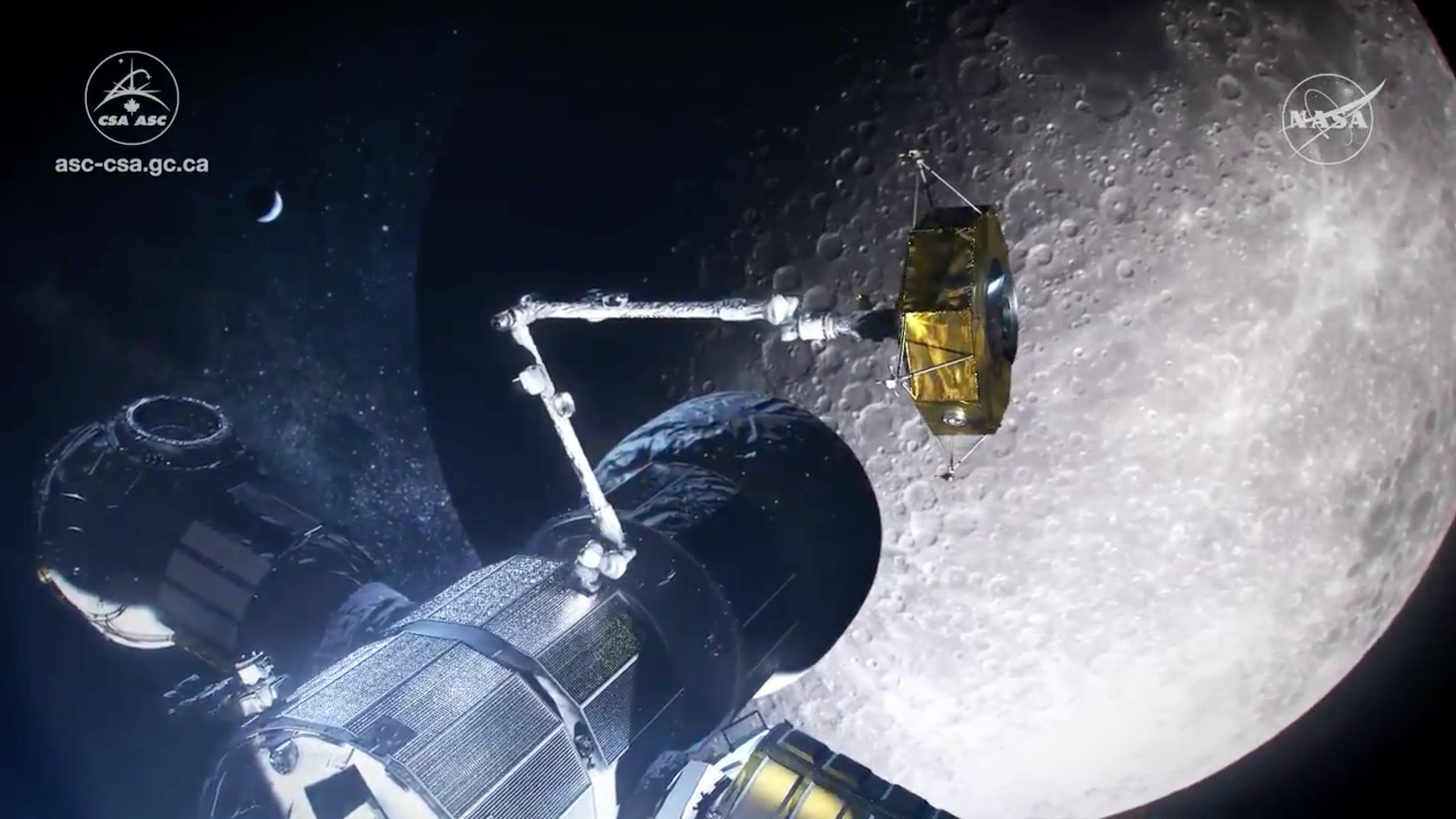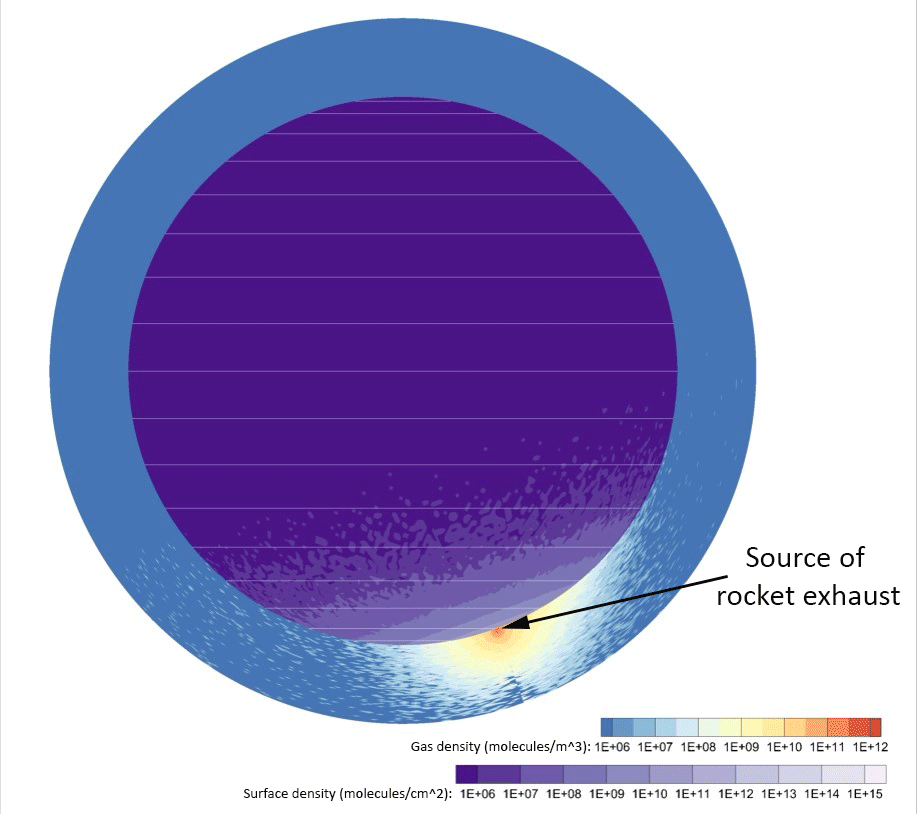Moon Monday Issue #6
Chang’e 5 brings home Moon samples, Canada to provide key Gateway element, understanding lunar dust, a 3D Moon rock viewer, and more developments in the lunar space.
Highlight

China has successfully completed their Chang’e 5 mission by bringing samples from the geologically young and unique Rümker region on the Moon. The roughly 300-kilogram return capsule separated from the orbital module on December 16 at 5,000 kilometers above sea level. The capsule performed a skip reentry in Earth’s atmosphere at 17:33 UTC, effectively bouncing off the atmosphere to reduce its speed before entering again, and landed in inner Mongolia at 17:59 UTC.
After the return capsule separated from the Chang’e-5 orbiter module, the latter performed a burn to avoid reentering the atmosphere, and is now headed for an extended mission to Sun-Earth Lagrange point 1 to carry out observations of the Sun and perform operational tests. The extended mission was made possible thanks to the accurate orbital injection by the Long March 5 rocket, which left the Chang’e-5 orbiter module with more than 200 kilograms of propellant for further maneuvers.
The returned capsule was weighed to have brought back 1.73 kilograms of samples, instead of the planned 2 kilograms. That’s because the drill sampling was restricted to a depth of 1 meter instead of the planned 2 meters, as it turned out that the subsurface was more rocky than expected.
The Chang’e 5 samples were transferred to the “Chinese Academy of Sciences National Astronomical Laboratory” in Beijing where a lab has been specifically constructed to store and study the samples. Speaking at a news conference, China National Space Administration’s deputy head Wu Yanhua said, among other interesting things, that a portion of the samples will be displayed at China's National Museum.
Chang’e 6, the backup mission for Chang’e 5, will now be repurposed for collecting samples from the Moon’s south pole in 2023. Wu said if the Queqiao satellite being used to relay Chang’e 4 communications seems to be functioning well till then and beyond, Chang’e 6 may land on the Moon’s farside instead, to bring samples from the South Pole-Aitken basin, a feature of immense scientific importance.
Related: Chang’e 5 marks China’s third successful Moon landing mission in just one decade. Here’s a perspective piece on why China is so focused on the Moon from Dr. Namrata Goswami, a senior analyst and author specializing in space policy and geopolitics.
Exploration
When assembling the Orion spacecraft at Kennedy Space Center in Florida for the Artemis I launch in November 2021, engineers identified a failure of a redundant channel on one of the spacecraft’s Power and Data Unit communication cards. Due to the “limited accessibility to this particular box, the degree of intrusiveness to the overall spacecraft systems, and other factors”, NASA made the decision to proceed with the mission as is, given that the primary channel is functioning fine, and the flight doesn’t have humans onboard. Meanwhile, an Orion simulator has arrived at the agency’s Johnson Space Center to train astronauts in for the crewed Artemis II flight.
NASA and the Canadian Space Agency (CSA) finalized an agreement on December 16 for the Artemis program. Under this agreement, CSA will provide and operate the Gateway’s external robotics system, including an autonomy-capable Canadarm3 robotic arm and interfaces for Gateway modules to install payloads. The agreement also sees NASA provide two crew opportunities for Canadian astronauts on Artemis missions, one to the Gateway and one on Artemis II.

Targeting a 2026 launch, Canadarm3 is being designed to move end-over-end to reach many parts of the Gateway’s exterior so that it can perform maintenance, repairs and inspection of the Gateway, capture visiting spacecraft, help astronauts during spacewalks and service external payloads. CSA is holding a free session on January 14 where Canadarm3’s prime contractor, MDA, which the agency recently awarded $22.8 million to progress the same, will provide details of the system.
Brazil has expressed formal interest in signing the Artemis Accords, which NASA calls “a practical set of principles to guide cooperation among nations participating in NASA’s 21st century lunar exploration plans”. If they sign the Accords, Brazil will become the tenth country in the list. They want to contribute a robotic lunar rover and other science experiments to the Artemis program. Of the major space nations, Russia, China and India are notably missing from the list of signatories of the Accords. Related: Some people in the space law and policy community are concerned that the Accords could have the opposite effect, and increase competition and rivalry in space.
On November 22, NASA successfully tested a prototype sensor called Ejecta STORM developed by UCF researchers to detect and quantify ejected Moon dust using lasers on the spacecraft. The test was done on a lunar soil simulant in USA’s Mojave desert with the sensor onboard a tethered Masten-built Xodiac vertical takeoff and vertical landing system, which functions much like a lunar lander. Here’s a slow motion video to see dust being blown by Xodiac’s exhaust (timestamp on the bottom left).

Understanding the physics of how spacecraft landing and taking off from the Moon’s surface blows dust and precisely quantifying it allows NASA to develop and calibrate predictive software that can protect future surface spacecraft, habitats and even low-flying orbiters from hazardous lunar dust from any kind of a surface mission (Hello Starship 👋). The UCF team now aims to build and test a higher fidelity prototype sensor with spaceflight-like thermal controls and space grade electronics on Earth before they can target be a real lunar lander flight.
A related NASA experiment called Surface Exosphere Alterations by Landers (SEAL) will be flying on Astrobotic’s first Moon landing mission in 2021, and will investigate how a spacecraft landing affects the composition of the soil and samples collected nearby.
Science
Using orbital data from NASA LRO, JAXA SELENE and ISRO Chandrayaan 1, scientists have produced a new geological map of the Apollo 12 landing region. The entire geopackage will be available on the PlanMap project website in the coming weeks. Maps on PlanMap combine different products like imagery, DTMs, spectral and chemical data, radar products and ground truth information from past and ongoing missions into a comprehensive package.

New simulations show that ejected material from large impacts on the Moon’s poles have mixed in with and buried water ice in the permanently shadowed regions to significant depths. This means foreseeable future missions extracting regolith are likely to find thinner layers of water ice that are younger rather than pristine swaths of old water ice deposits sitting deep down.
Several Apollo astronauts observed glows over the lunar horizon, suggesting a dense dust exosphere near the lunar terminator. But later lunar missions have mysteriously failed to see the same. Now scientists report five increased dust measurements comparable to Apollo taken by the Lunar Dust Experiment onboard NASA’s LADEE mission near a twilight crater. The Apollo observations were near similar twilight craters too, suggesting that the phenomenon may not be global.
More Moon
NASA’s ARES division has launched a new website called Astromaterials 3D, which allows users to view the agency’s collection of Apollo and meteorite rocks in an information-rich 3D viewer and manipulator, almost as if a rock is in your hands (if opening the Explorer on a mobile browser, request the site’s Desktop version to be able to use it). Site visitors can follow each rock’s history, watch actual footage of the specimen being collected by the astronaut in case of Apollo and even slice the samples. The site currently includes 10 meteorites and lunar samples each, and more will be added next year. The team created these models using an elaborate process that includes manually photographing the rocks from at least 240 different angles in a nitrogen cabinet in a cleanroom using a raft of scanning tools.
Also check out virtualmicroscope.org, where more than 500 Apollo samples are available to see with a virtual microscope! 🤓
💯 lunatics
Moon Monday crossed 100 subscribers last week, in just over a week after public launch! 🚀
If you like the newsletter, please share it with friends, colleagues or your followers on socials.
Also, I’m putting out Moon Monday for absolutely free of cost, and the site is free to access and had no ads. If you like what you read, consider supporting me.
